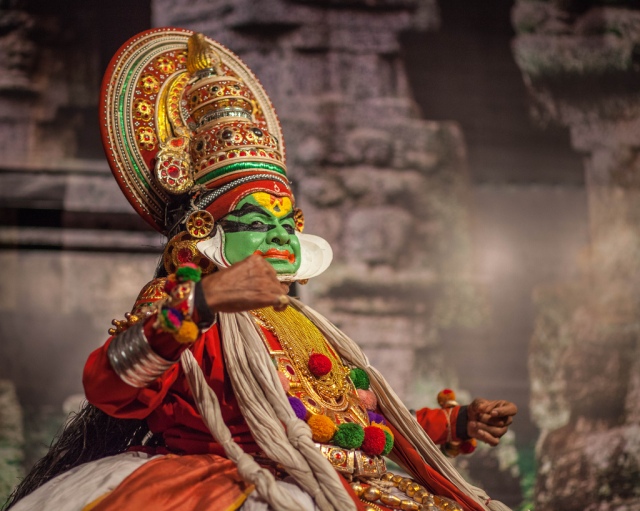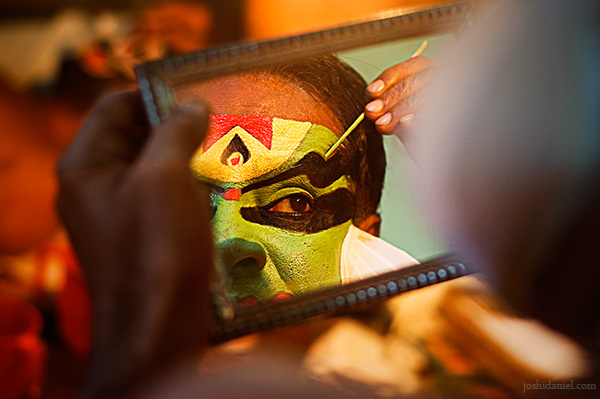
Kathakali is one of the major forms of classical Indian dance.It is a “story play” genre of art, but one distinguished by the elaborately colourful make-up, costumes and face masks that the traditionally male actor-dancers wear. Kathakali primarily developed as a Hindu performance art in the Malayalam-speaking southwestern region of India, in Kerala.

Kathakali’s roots are unclear. The fully developed style of Kathakali originated around the 17th century, but its roots are in the temple and folk arts (such as Kutiyattam and religious drama of the southwestern Indian peninsula), which are traceable to at least the 1st millennium CE. A Kathakali performance, like all classical dance arts of India, synthesises music, vocal performers, choreography and hand and facial gestures together to express ideas. However, Kathakali differs in that it also incorporates movements from ancient Indian martial arts and athletic traditions of South India. Kathakali also differs in that the structure and details of its art form developed in the courts and theatres of Hindu principalities, unlike other classical Indian dances which primarily developed in Hindu temples and monastic schools.

The traditional themes of the Kathakali are folk mythologies, religious legends and spiritual ideas from the Hindu epics and the Puranas. The vocal performance has traditionally been performed in Sanskritised Malayalam.

A Kathakali repertoire is an operatic performance where an ancient story is playfully dramatized. Traditionally, a Kathakali performance is long, starting at dusk and continuing through dawn, with interludes and breaks for the performers and audience. Some plays continued over several nights, starting at dusk everyday. Modern performances are shorter. The stage with seating typically in open grounds outside a temple, but in some places, special theatres called Kuttampalam built inside the temple compounds have been in use.
The stage is mostly bare, or with a few drama-related items. One item, called a Kalivilakku (kali meaning dance; vilakku meaning lamp), can be traced back to Kuttiyattam. In both traditions, the performance happens in the front of a huge Kalivilakku with its thick wick sunk in coconut oil, burning with a yellow light. Traditionally, before the advent of electricity, this special large lamp provided light during the night. As the play progressed, the actor-dancers would gather around this lamp so that audience could see what they are expressing.
The performance involves actor-dancers in the front, supported by musicians in the background stage on right (audience’s left) and with vocalists in the front of the stage (historically so they could be heard by the audience before the age of microphone and speakers). Typically, all roles are played by male actor-dancers, though in modern performances, women have been welcomed into the Kathakali tradition.


Of all classical Indian dances, Kathakali has the most elaborate costuming consisting of head dresses, face masks and vividly painted faces. It typically takes several evening hours to prepare a Kathakali troupe to get ready for a play. Costumes have made Kathakali’s popularity extend beyond adults, with children absorbed by the colors, makeup, light and sound of the performance.
The makeup follows an accepted code, that helps the audience easily identify the archetypical characters such as gods, goddesses, demons, demonesses, saints, animals and characters of a story. Seven basic makeup types are used in Kathakali, namely Pachcha (green), Pazhuppu (ripe), Kathi(knife), Kari, Thaadi, Minukku and Teppu. These vary with the styles and the predominant colours made from rice paste and vegetable colors that are applied on the face. Pachcha (green) with lips painted brilliant coral red portrays noble characters and sages such as Krishna, Vishnu, Arjun, Nala and philosopher-kings.

Tati (red) is the code for someone with an evil streak such as Ravana, Dushasana and Hiranyakashipu. Some characters have green face (representing heroic or excellences as a warrior) with red dots or lines on their cheeks or red colored mustache or red streaked beard (representing evil inner nature), while others have full face and beard colored red, the latter implying excessively evil characters. Kari (black) is the code for forest dwellers, hunters, and middle ground character. Demonesses and treacherous characters are also painted black but with streaks or patches of red.

Yellow is the code for monks, mendicants and women. Minukka (radiant, shining) with a warm yellow, orange or saffron typifies noble, virtuous feminine characters such as Sita. Panchali and Mohini . Men who act the roles of women also add a false top knot to their left and decorate it in a style common to the region. Vella Thadi (white beard) represents a divine being, someone with virtuous inner state and consciousness such as Hanuman. Teppu are for special characters found in Hindu mythologies, such as Garuda, Jatayu and Hamsa who act as messengers or carriers, but do not fit the other categories. Face masks and head gear is added to accentuate the inner nature of the characters. The garments colors have a similar community accepted code of silent communication.

DANCER??
Want to become FAMOUS??
Show us your talent, We will make it Shine.
We, at Art Directory India, provide artists a platform where artists can display their talent, where recruiters see your work hire you.
Register now https://artdirectoryindia.in/talent/